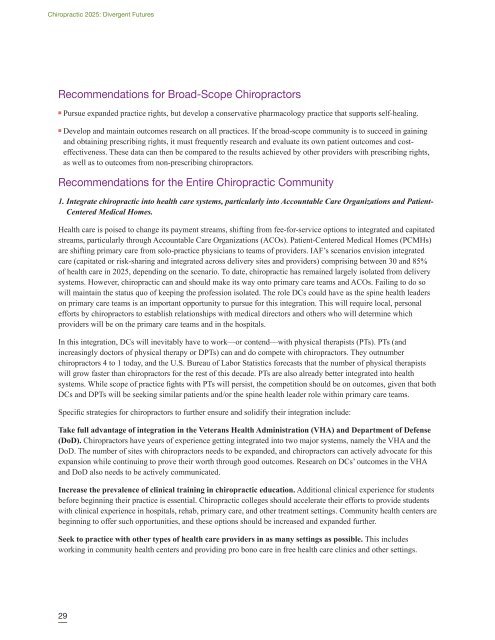Chiropractic 2025:
Chiropractic 2025:
Chiropractic 2025:
You also want an ePaper? Increase the reach of your titles
YUMPU automatically turns print PDFs into web optimized ePapers that Google loves.
<strong>Chiropractic</strong> <strong>2025</strong>: Divergent Futures<br />
Recommendations for Broad-Scope Chiropractors<br />
■ Pursue expanded practice rights, but develop a conservative pharmacology practice that supports self-healing.<br />
■ Develop and maintain outcomes research on all practices. If the broad-scope community is to succeed in gaining<br />
and obtaining prescribing rights, it must frequently research and evaluate its own patient outcomes and costeffectiveness.<br />
These data can then be compared to the results achieved by other providers with prescribing rights,<br />
as well as to outcomes from non-prescribing chiropractors.<br />
Recommendations for the Entire <strong>Chiropractic</strong> Community<br />
1. Integrate chiropractic into health care systems, particularly into Accountable Care Organizations and Patient-<br />
Centered Medical Homes.<br />
Health care is poised to change its payment streams, shifting from fee-for-service options to integrated and capitated<br />
streams, particularly through Accountable Care Organizations (ACOs). Patient-Centered Medical Homes (PCMHs)<br />
are shifting primary care from solo-practice physicians to teams of providers. IAF’s scenarios envision integrated<br />
care (capitated or risk-sharing and integrated across delivery sites and providers) comprising between 30 and 85%<br />
of health care in <strong>2025</strong>, depending on the scenario. To date, chiropractic has remained largely isolated from delivery<br />
systems. However, chiropractic can and should make its way onto primary care teams and ACOs. Failing to do so<br />
will maintain the status quo of keeping the profession isolated. The role DCs could have as the spine health leaders<br />
on primary care teams is an important opportunity to pursue for this integration. This will require local, personal<br />
efforts by chiropractors to establish relationships with medical directors and others who will determine which<br />
providers will be on the primary care teams and in the hospitals.<br />
In this integration, DCs will inevitably have to work—or contend—with physical therapists (PTs). PTs (and<br />
increasingly doctors of physical therapy or DPTs) can and do compete with chiropractors. They outnumber<br />
chiropractors 4 to 1 today, and the U.S. Bureau of Labor Statistics forecasts that the number of physical therapists<br />
will grow faster than chiropractors for the rest of this decade. PTs are also already better integrated into health<br />
systems. While scope of practice fights with PTs will persist, the competition should be on outcomes, given that both<br />
DCs and DPTs will be seeking similar patients and/or the spine health leader role within primary care teams.<br />
Specific strategies for chiropractors to further ensure and solidify their integration include:<br />
Take full advantage of integration in the Veterans Health Administration (VHA) and Department of Defense<br />
(DoD). Chiropractors have years of experience getting integrated into two major systems, namely the VHA and the<br />
DoD. The number of sites with chiropractors needs to be expanded, and chiropractors can actively advocate for this<br />
expansion while continuing to prove their worth through good outcomes. Research on DCs’ outcomes in the VHA<br />
and DoD also needs to be actively communicated.<br />
Increase the prevalence of clinical training in chiropractic education. Additional clinical experience for students<br />
before beginning their practice is essential. <strong>Chiropractic</strong> colleges should accelerate their efforts to provide students<br />
with clinical experience in hospitals, rehab, primary care, and other treatment settings. Community health centers are<br />
beginning to offer such opportunities, and these options should be increased and expanded further.<br />
Seek to practice with other types of health care providers in as many settings as possible. This includes<br />
working in community health centers and providing pro bono care in free health care clinics and other settings.<br />
29


